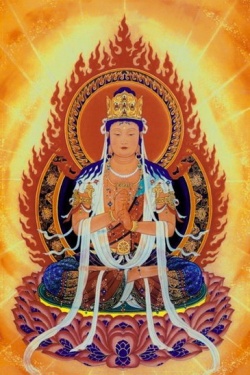Mahavairochana
Mahavairochana
[大日如来] (Skt; Jpn Dainichi-nyorai)
The Thus Come One Mahavairochana. A Buddha worshiped in Esoteric Buddhism. The Sanskrit name Mahavairochana is a compound of maha, meaning great, and vairochana, meaning that which is of, related to, or luminous like the sun. It is translated in Chinese Buddhist scriptures as "Great Sun." This Buddha appears in the Mahavairochana Sutra and the Diamond Crown Sutra. He is regarded as the Buddha of the Dharma body who personifies the unchanging truth of all phenomena and is the source from which all Buddhas and bodhisattvas spring. Esoteric Buddhism holds that Mahavairochana is always expounding the teaching, and that common mortals can become one with this Buddha through the practice of the three mysteries—the forming of mudras with the hands, the recitation of mantras (magical formulas), and meditation on an esoteric mandala or one of the figures appearing in it. Mahavairochana has two aspects, the Mahavairochana of the Womb Realm, who represents the fundamental truth of the universe, and the Mahavairochana of the Diamond Realm, who represents wisdom. These two are fundamentally one. In Japan, Tendai Esotericism and True Word (Shingon) Esotericism differ in their interpretations of Mahavairochana. The former holds that Mahavairochana is the Buddha of the Dharma body, and that Shakyamuni is the Buddha of the manifested body, or a temporary manifestation of the Buddha of the Dharma body. The latter maintains that they are two entirely distinct and separate Buddhas.
